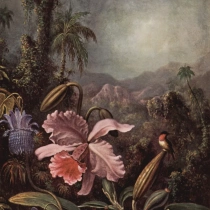 1819 - 1904
hudson river school
1819 - 1904
hudson river school
Description Martin Johnson Heade
Martin Johnson Heade, a luminary of 19th-century American art, forged a distinctive path within the Hudson River School, embracing a fusion of naturalism and luminism that set him apart. Born in 1819, Heade's journey unfolded against the changing landscapes of both art and the American nation.
Heade's early career meandered through portraiture and genre scenes, but it was his fascination with the beauty of nature, particularly the hummingbird, that ignited a transformative artistic trajectory. His hummingbird series, marked by meticulous detail and vibrant hues, captured not just the ornithological precision but the ethereal poetry of these tiny creatures in flight.
Venturing beyond the traditional landscapes, Heade's marsh scenes became iconic. His portrayal of the salt marshes of New England, with their luminous atmospheres and teeming biodiversity, elevated him into the realms of the luminist movement. The celebrated "Giant Magnolias on a Blue Velvet Cloth" exemplifies Heade's ability to infuse botanical subjects with a radiant, almost mystical quality.
Heade's life was not confined to the canvas; he was a man of diverse interests. His travels across the Americas, from South America to Florida, exposed him to a myriad of ecosystems, fueling his artistic explorations. Beyond the lush landscapes, he ventured into depictions of thunderstorms, tropical forests, and seascapes, capturing the sublime forces of nature.
The artist's complexity extended to his personal life. Reclusive and enigmatic, Heade's interests spanned beyond art to include spirituality and philosophy. His membership in spiritualist communities and fascination with transcendentalism added layers to his character, reflecting the intellectual currents of his time.
Despite his artistic brilliance, Heade's work did not gain widespread recognition during his lifetime. His unconventional approach, straddling genres and defying artistic norms, contributed to this relative obscurity. It was only posthumously, as the appreciation for American luminism grew, that Heade's contributions received the acclaim they deserved.
Martin Johnson Heade passed away in 1904, leaving behind a legacy that defied categorization. His ability to encapsulate the grandeur of nature with an almost mystical quality, coupled with his enigmatic persona, secured him a unique place in American art. Heade's oeuvre remains an invitation to explore the intricate dance between the tangible and the transcendent, where every brushstroke unveils the profound beauty inherent in the natural world.








No Comments Yet...